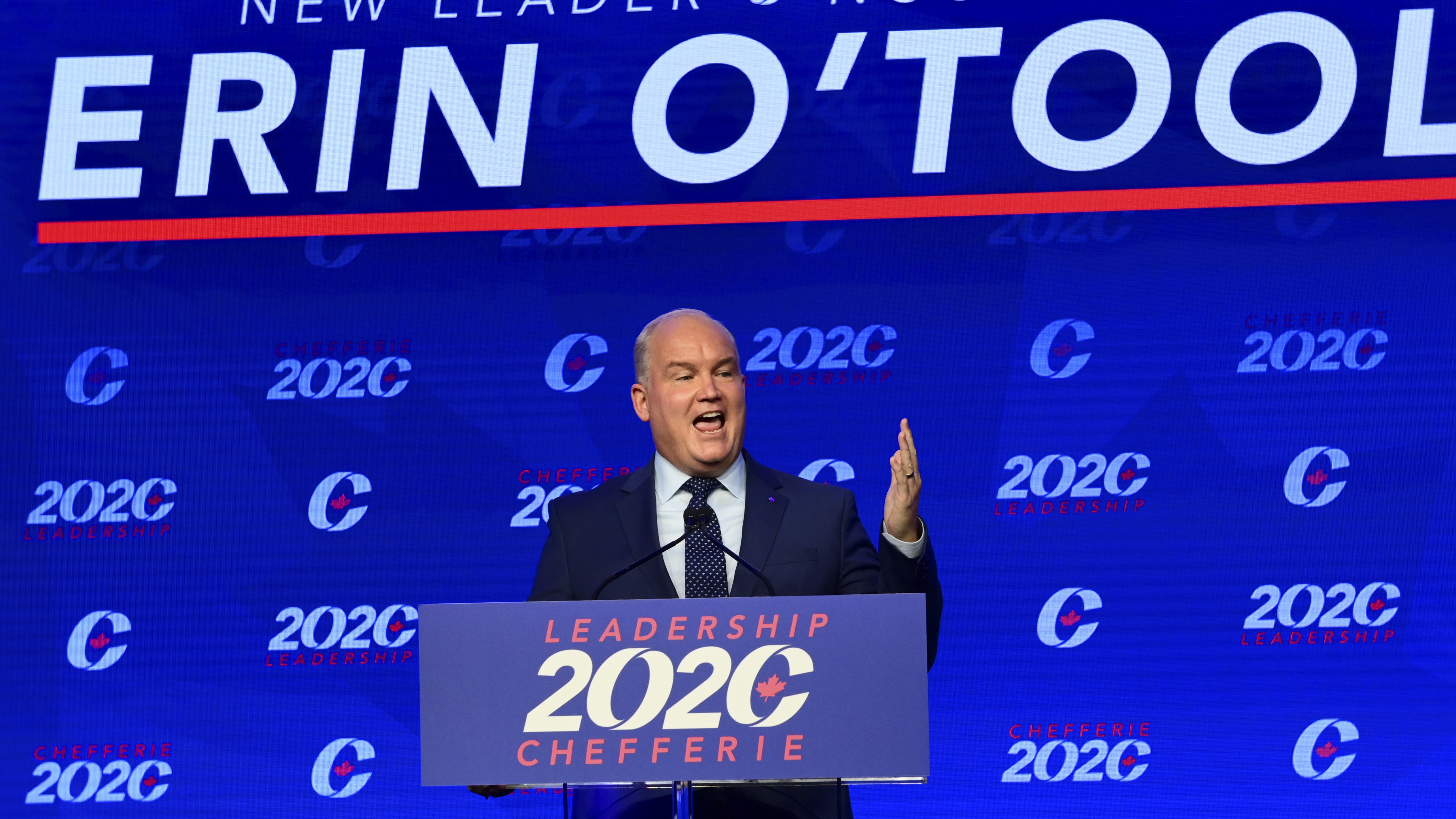Canadian Conservatives ‘learning from Boris Johnson’ in effort to defeat Justin Trudeau
Erin O’Toole drafts in architects of UK PM’s 2019 win as battle with Liberals goes to the wire

In calling a snap election, Justin Trudeau was looking to pull off a feat of majority-building comparable to Boris Johnson’s success two years ago. But instead it is his Conservative rivals who have taken a leaf out of the UK prime minister’s book.
Erin O’Toole, the man aiming to unseat liberal Trudeau as Canada’s PM, has “modelled his tactics on Boris Johnson and David Cameron’s victories”, according to The Telegraph, even going as far as to hire “strategists from the Conservatives’ 2019 win”.
And the tactic of “learning from Johnson” may pay dividends. O’Toole is “now within striking distance of achieving that goal” when Canada goes to the polls on 20 September, the paper added.
The Week
Escape your echo chamber. Get the facts behind the news, plus analysis from multiple perspectives.

Sign up for The Week's Free Newsletters
From our morning news briefing to a weekly Good News Newsletter, get the best of The Week delivered directly to your inbox.
From our morning news briefing to a weekly Good News Newsletter, get the best of The Week delivered directly to your inbox.
Form of flattery
When Trudeau called the snap election last month, his Liberal Party was leading in the polls and his strategy appeared to be a safe route to securing a larger majority. Just a month later, however, the race has tightened significantly.
To understand what has happened, said The Globe and Mail’s national affairs columnist Gary Mason, you must first “travel back in time” to the UK Conservative Party’s 2005 conference in Blackpool.
“On stage,” Mason said, “is a 39-year-old David Cameron, who is vying for his party’s leadership.” After a third general election defeat at the hands of Labour, Cameron is about to set out “a vision to alter the way Conservatives approach everything from education to health care”.
A free daily email with the biggest news stories of the day – and the best features from TheWeek.com
“He would leave the convention as his party’s next leader” and “five years later, he would be prime minister”, Mason added. The realignment of Cameron’s Tories has “become an explicit reference point” for O’Toole and his “brain trust”.
What O’Toole has successfully pulled off is a similar feat to Cameron’s “one nation Toryism”, namely a change in the Canadian “Conservative playbook” aimed at targeting the country’s “blue collar vote”, said commentator John Ivison in the National Post.
Rather than appealing only to the Conservatives’ traditional base, O’Toole has shifted the party’s appeal to “people who have been left behind by globalism but who also shun identity politics”, Ivison added. And his party’s fortunes have risen as a result.
In redefining his party, O’Toole has picked up “lessons from everywhere”, Ivison continued, most notably “Johnson’s emphatic victory” two years ago in which he decimated the UK Labour Party in their old stronghold, namely the so-called “red wall”.
O’Toole has mimicked this success by making “speeches bemoaning the fall in the union membership” and issuing “a Labour Day statement calling for an economic policy that puts workers first”, Ivison added, closely resembling Johnson’s “levelling-up” agenda.
He has also pledged “to spend an extra $60bn [£43.2m] on healthcare over the next 10 years”, a promise the Liberals are yet to counter. This has shifted his party’s position on what has often been a “defensive issue for Conservatives” in order to mimic “Johnson’s commitment in the British election to provide more nurses and funding for the NHS”.
A source in O’Toole’s campaign told The Telegraph that his aides “studied what Cameron did very closely” in terms of his rebranding of the UK Conservative Party 15 years ago, as well as Johnson’s “success winning back blue collar voters in the 2019 election”.
The paper added that “former advisers to Johnson who helped secure him a majority in that vote have also been hired”, including James Kanagasooriam, who runs data company Stack Data Strategy, and Sean Topham, of consultancy firm Topham Guerin.
O’Toole has nosed ahead in polls and now has a 54% chance of winning the most seats, according to projections by polling aggregator 338Canada.com. Such is the success of his party’s campaign that the Conservatives are “even with the Liberals in vote-rich Ontario and have a strong lead in the western provinces”, Bloomberg added.
New conservatism
As Johnson has faced criticism over manifesto-busting pledges, O’Toole’s “strategy has faced a strong internal backlash”, Ivison said. Critics have argued that “if the Conservative Party doesn’t stand for free trade, a market economy and small government, what does it stand for?”.
But O’Toole, like Johnson, has “faced down the doubters in his own party and crafted an election platform brimming with measures aimed at appealing to people who may not be traditional Conservative voters”, he added.
The campaign “is changing Canadian conservatism as we know it”, according to Mason. He suggested that “Tories have tried to court the working class and take the climate crisis more seriously, while risking alienating social conservatives”.
“Perhaps the biggest change,” he added, “has been a new focus on the working-class voter.” Pledges have included the extension of Employment Insurance sickness benefits, paying 25% of salaries for new hires for six months and requiring federally regulated employers to include worker representation on their boards.
In this regard, “there are key differences to the UK comparison”, Ivison added in the National Post. But what unites O’Toole and Johnson is an attempt to – at least partially – “realign conservative dogma”, Mason added.
In 2019, Johnson “showed it was possible to mine a whole new group of voters: disaffected blue-collar workers,” he said. The Canadian Conservatives now “have work to do here if they hope to see their strategy pay off in the same way”.
-
 Pakistan: Trump’s ‘favourite field marshal’ takes charge
Pakistan: Trump’s ‘favourite field marshal’ takes chargeIn the Spotlight Asim Munir’s control over all three branches of Pakistan’s military gives him ‘sweeping powers’ – and almost unlimited freedom to use them
-
 Codeword: December 6, 2025
Codeword: December 6, 2025The daily codeword puzzle from The Week
-
 Crossword: December 6, 2025
Crossword: December 6, 2025The daily crossword from The Week
-
 Femicide: Italy’s newest crime
Femicide: Italy’s newest crimeThe Explainer Landmark law to criminalise murder of a woman as an ‘act of hatred’ or ‘subjugation’ but critics say Italy is still deeply patriarchal
-
 Brazil’s Bolsonaro behind bars after appeals run out
Brazil’s Bolsonaro behind bars after appeals run outSpeed Read He will serve 27 years in prison
-
 Americans traveling abroad face renewed criticism in the Trump era
Americans traveling abroad face renewed criticism in the Trump eraThe Explainer Some of Trump’s behavior has Americans being questioned
-
 Nigeria confused by Trump invasion threat
Nigeria confused by Trump invasion threatSpeed Read Trump has claimed the country is persecuting Christians
-
 Sanae Takaichi: Japan’s Iron Lady set to be the country’s first woman prime minister
Sanae Takaichi: Japan’s Iron Lady set to be the country’s first woman prime ministerIn the Spotlight Takaichi is a member of Japan’s conservative, nationalist Liberal Democratic Party
-
 Russia is ‘helping China’ prepare for an invasion of Taiwan
Russia is ‘helping China’ prepare for an invasion of TaiwanIn the Spotlight Russia is reportedly allowing China access to military training
-
 Interpol arrests hundreds in Africa-wide sextortion crackdown
Interpol arrests hundreds in Africa-wide sextortion crackdownIN THE SPOTLIGHT A series of stings disrupts major cybercrime operations as law enforcement estimates millions in losses from schemes designed to prey on lonely users
-
 China is silently expanding its influence in American cities
China is silently expanding its influence in American citiesUnder the Radar New York City and San Francisco, among others, have reportedly been targeted